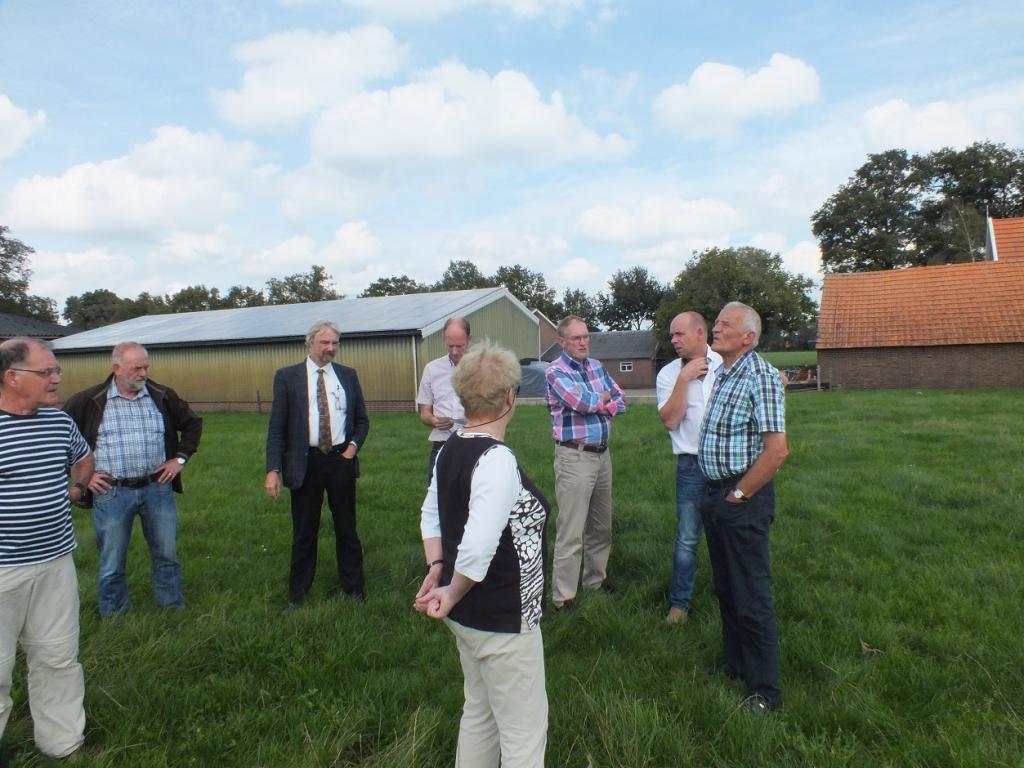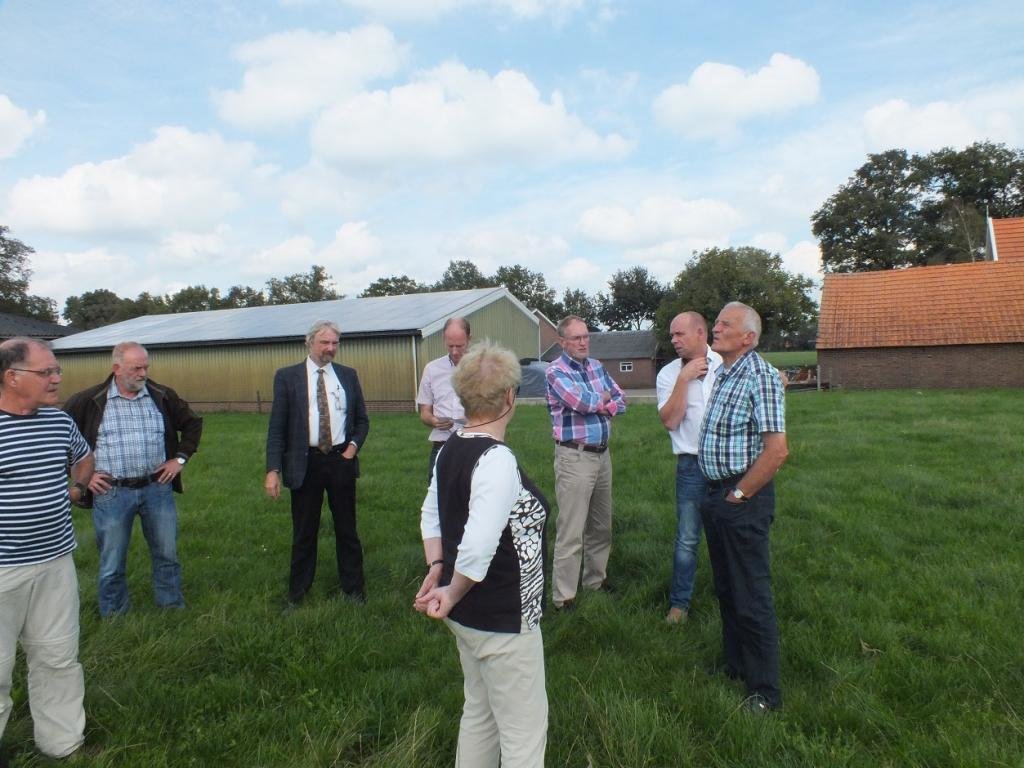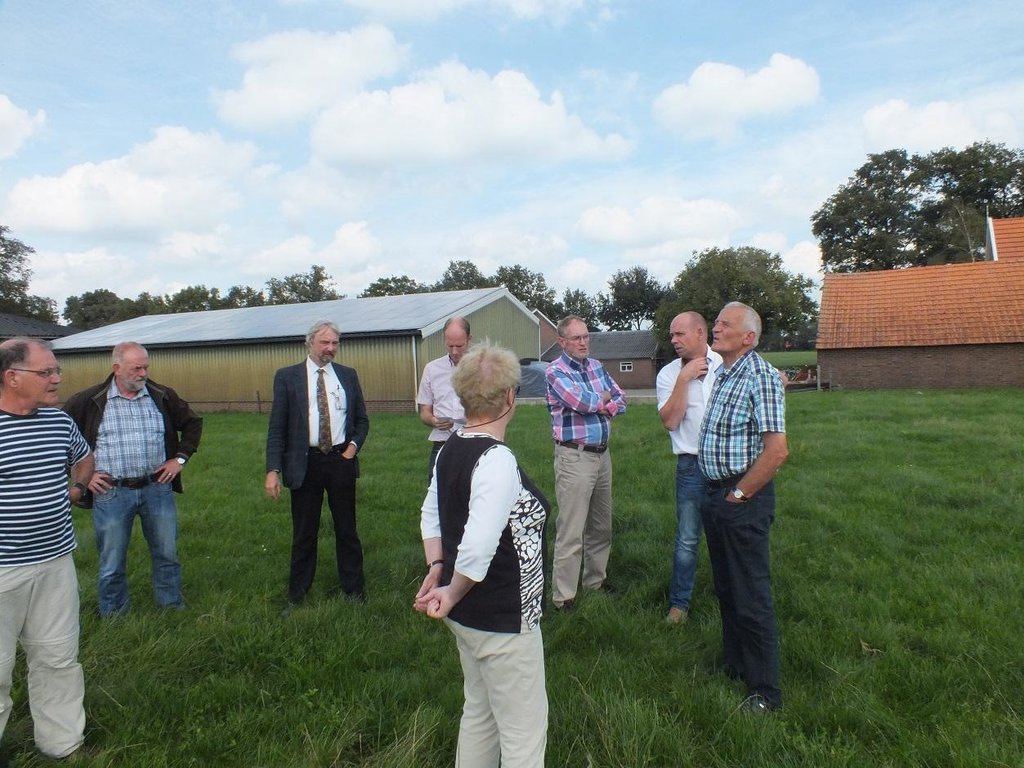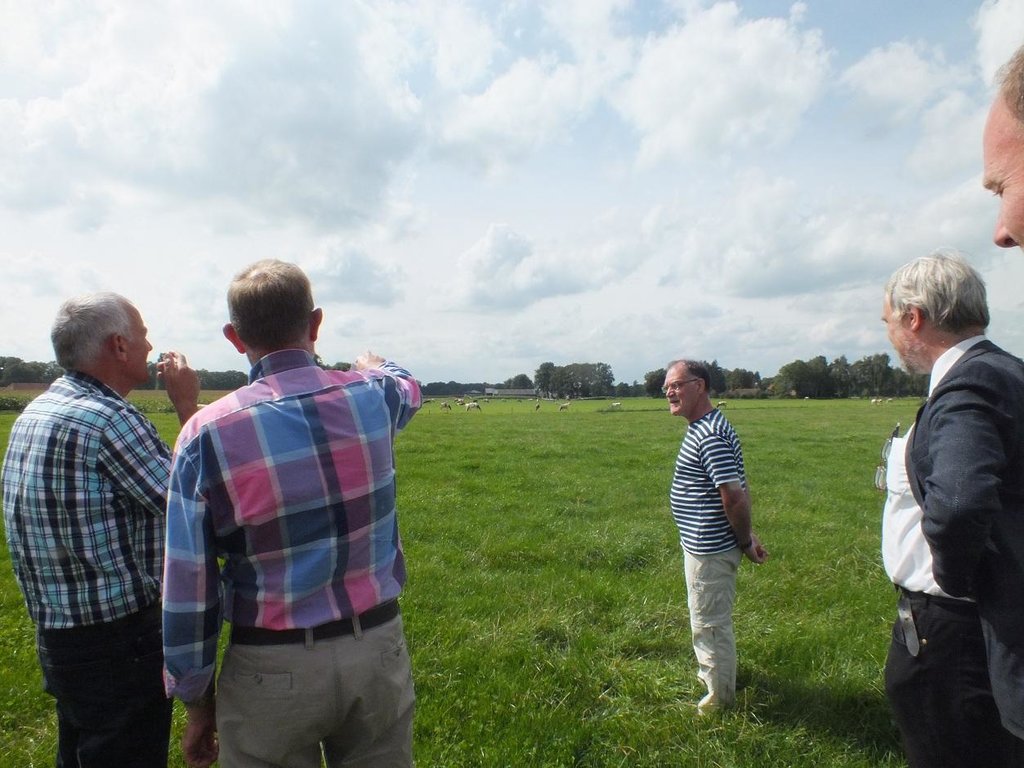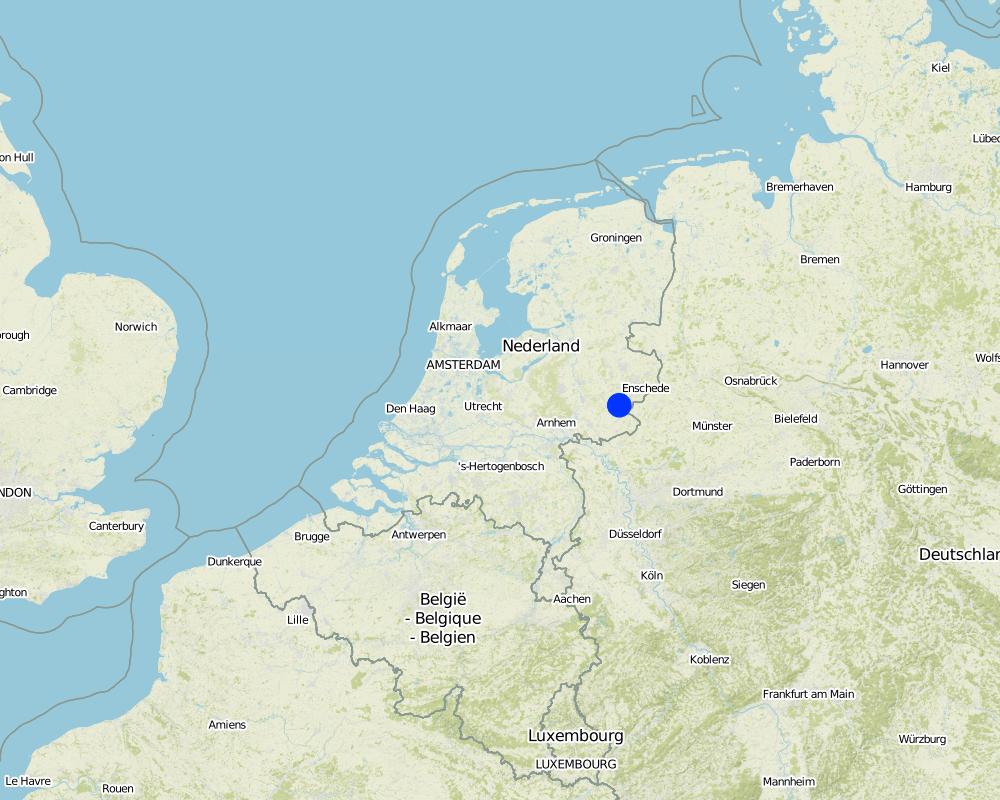Regional process, social innovation [ເນເທີແລນ]
- ການສ້າງ:
- ປັບປູງ:
- ຜູ້ສັງລວມຂໍ້ມູນ: Simone Verzandvoort
- ບັນນາທິການ: –
- ຜູ້ທົບທວນຄືນ: Fabian Ottiger
Gezond Zand aanpak (Dutch)
approaches_2523 - ເນເທີແລນ
ເບິ່ງພາກສ່ວນ
ຂະຫຍາຍທັງໝົດ ຍຸບທັງໝົດ1. ຂໍ້ມູນທົ່ວໄປ
1.2 ລາຍລະອຽດ ການຕິດຕໍ່ ຂອງບຸກຄົນທີ່ຊັບພະຍາກອນ ແລະ ສະຖາບັນ ການມີສ່ວນຮ່ວມ ໃນການປະເມີນຜົນ ແລະ ເອກະສານ ຂອງວິທີທາງ
ຜູ້ຊ່ຽວຊານ ດ້ານການຄຸ້ມຄອງ ທີ່ດິນແບບຍືນຍົງ:
Smit Annemieke
Alterra-Wageningen UR
ເນເທີແລນ
ຜູ້ຊ່ຽວຊານ ດ້ານການຄຸ້ມຄອງ ທີ່ດິນແບບຍືນຍົງ:
Rienks Willem
ROM3D
ເນເທີແລນ
ຊື່ຂອງ ສະຖາບັນການຈັດຕັ້ງ ທີ່ອໍານວຍຄວາມສະດວກ ໃນການສ້າງເອກກະສານ ຫຼື ປະເມີນແນວທາງ (ຖ້າກ່ຽວຂ້ອງ)
Wageningen Environmental Research (Alterra) - ເນເທີແລນຊື່ຂອງ ສະຖາບັນການຈັດຕັ້ງ ທີ່ອໍານວຍຄວາມສະດວກ ໃນການສ້າງເອກກະສານ ຫຼື ປະເມີນແນວທາງ (ຖ້າກ່ຽວຂ້ອງ)
Hoe Duurzaam - ເນເທີແລນຊື່ຂອງ ສະຖາບັນການຈັດຕັ້ງ ທີ່ອໍານວຍຄວາມສະດວກ ໃນການສ້າງເອກກະສານ ຫຼື ປະເມີນແນວທາງ (ຖ້າກ່ຽວຂ້ອງ)
Provincie Gelderland - ເນເທີແລນຊື່ຂອງ ສະຖາບັນການຈັດຕັ້ງ ທີ່ອໍານວຍຄວາມສະດວກ ໃນການສ້າງເອກກະສານ ຫຼື ປະເມີນແນວທາງ (ຖ້າກ່ຽວຂ້ອງ)
ROM3D - ເນເທີແລນຊື່ຂອງ ສະຖາບັນການຈັດຕັ້ງ ທີ່ອໍານວຍຄວາມສະດວກ ໃນການສ້າງເອກກະສານ ຫຼື ປະເມີນແນວທາງ (ຖ້າກ່ຽວຂ້ອງ)
Ministerie van Economische Zaken - ເນເທີແລນ1.3 ເງື່ອນໄຂ ຂອງການນໍາໃຊ້ເອກກະສານຂໍ້ມູນ ຂອງ WOCAT
ເມື່ອໃດທີ່ໄດ້ສັງລວມຂໍ້ມູນ (ຢູ່ພາກສະໜາມ)?
18/09/2014
ຜູ້ສັງລວມ ແລະ ບັນດາຜູ້ຕອບແບບສອບຖາມ ຍອມຮັບໃນເງື່ອນໄຂ ການນໍາໃຊ້ຂໍ້ມູນເອກະສານ ທີ່ສ້າງຂື້ນ ໂດຍຜ່ານ ອົງການ WOCAT:
ແມ່ນ
1.4 ເອກະສານອ້າງອີງ (ຫຼາຍ) ກັບແບບສອບຖາມ (ຫຼາຍ) ເຕັກໂນໂລຢີ ຂອງດ້ານການຄຸ້ມຄອງ ດິນແບບຍືນຍົງ
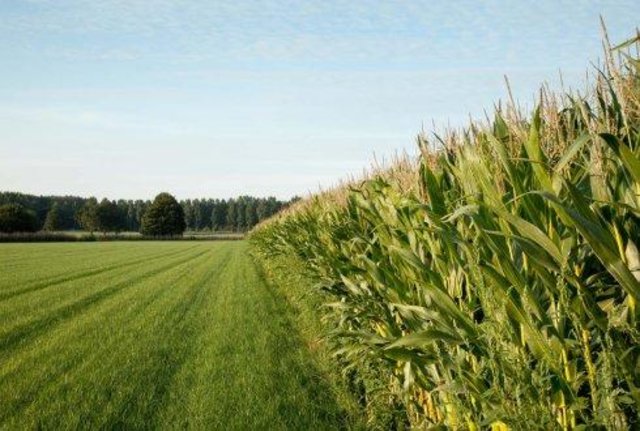
Postpone grassland renewal [ເນເທີແລນ]
Postponing the timing of ploughing a grassland field by one or two years to reduce nutrient losses and organic matter decomposition.
- ຜູ້ສັງລວມຂໍ້ມູນ: Jason Stuka
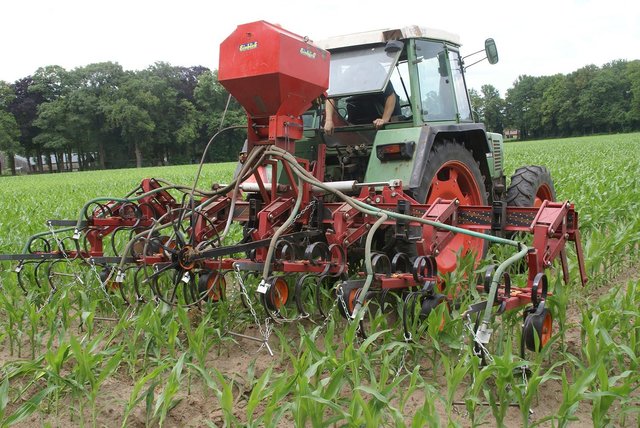
Intercropping of grass and corn to increase soil … [ເນເທີແລນ]
Grass intercropping on corn fields
- ຜູ້ສັງລວມຂໍ້ມູນ: Jason Stuka
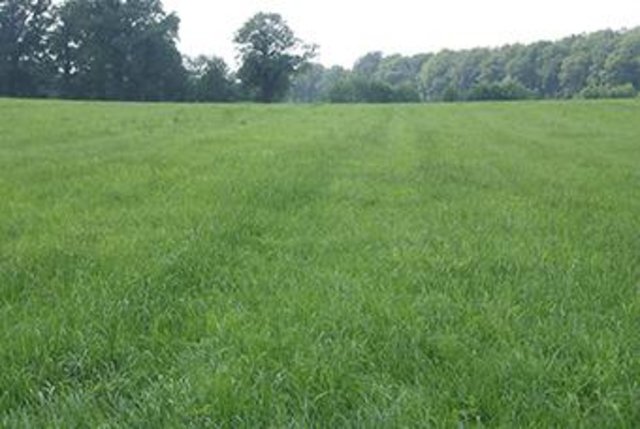
Humic acid application [ເນເທີແລນ]
Humic acid application is a technology that allows the farmer to supply organic matter to the soil, without supplying additional nitrogen and phosphorus.
- ຜູ້ສັງລວມຂໍ້ມູນ: Jason Stuka
2. ພັນລະນາ ແນວທາງການຄຸ້ມຄອງນໍາໃຊ້ດິນແບບຍືນຍົງ
2.1 ການອະທິບາຍ ໂດຍຫຍໍ້ ຂອງວິທີທາງ
Social innovation for sustained soil organic matter, clean drinking water and sustainable crop production
2.2 ການອະທິບາຍ ລາຍລະອຽດ ຂອງວິທີທາງ
ການອະທິບາຍ ລາຍລະອຽດ ຂອງວິທີທາງ:
Aims / objectives: A group of farmers cooperates with the drinking water company and aims for a more healthy soil. The sandy soil is low in organic matter. They expect that increasing the soil organic matter content will retain more nitrates in the soil, leading to a reduction in nitrate leaching and a higher nutrient availability for the crops.
Dairy farms grow grass and corn. Some farmers also produce potatoes and cereals.
Most farms deal with suboptimal moisture conditions. Increasing the soil organic matter content and improving the soil structure is expected to be a key factor in improving soil moisture content, both in dry and wet periods.
For most farmers soil biodiversity is terra incognita. During the project they will learn about the advantages of good soil fauna and how it can add to better crops.
The case study will explore management options to increase and maintain organic matter content in soil via different rotations, specific varieties of grasses and corn, cover crops and additions of organic amendments and fertilizers. Although the case study is about soil management and technology to improve soil quality, social innovation is a key objective: combining knowledge and experience of a group of neighbours and farmers within a small region and developing solutions and opportunities for the whole area.
Methods: lectures, site visits, group sessions with models (computer sessions), kitchen table interviews (interactive advice), providing relevant literature
Stages of implementation: fund raising - building support - knowledge transfer - pilots of measures - applied expert advice - launch of the foundation HOE Duurzaam - implementation of new measures - increase of nr of participants - field excursion - closing event of the project 'gezond Zand'
Role of stakeholders: Pioneer farmers : initiating and leading the project, fouding HOE Duurzaam
Other farmers : participating, implementing measures, sharing experience
VITENS Drinking water company: providing money and urgency
ROM3d : project leader, motivating farmers, intermediate between area and government
ALterra, Wageningen UR: providing knowledge
Other important information: An adjustment in the national regulations for manure application was an important driving factor for the development of the approach. Farmers were authorised to apply more manure per ha if they have 75% of their land under grassland. This criterion changed to 80% during the implementation of the approach.
2.3 ຮູບພາບຂອງແນວທາງ
2.5 ປະເທດ / ເຂດ / ສະຖານທີ່ບ່ອນທີ່ແນວທາງໄດ້ຖືກນໍາໃຊ້
ປະເທດ:
ເນເທີແລນ
ພາກພື້ນ / ລັດ / ແຂວງ:
Netherlands, Gelderland
ຂໍ້ມູນເພີ່ມເຕີມຂອງສະຖານທີ່:
Municipality of Berkelland
Map
×2.6 ວັນທີເລີ່ມຕົ້ນ ແລະ ສິ້ນສຸດ ການຈັດຕັ້ງປະຕີບັດ ວິທີທາງ
ສະແດງປີຂອງການເລີ່ມຕົ້ນ:
2011
ປີທີ່ສີ້ນສູດ (ຖ້າຢຸດບໍ່ໄດ້ນໍາໃຊ້ ວິທີທາງ):
2014
2.7 ປະເພດຂອງແນວທາງ
- ການລິເລີ່ມ ພາຍໃນປະເທດ ທີ່ຜ່ານມາ / ນະວັດຕະກໍາ
2.8 ເປົ້າໝາຍ / ຈຸດປະສົງຫຼັກ ຂອງການຈັດຕັ້ງປະຕິບັດ ວິທີທາງ
The Approach focused mainly on SLM with other activities (energy, landscape conservation, recreation, drinking water)
The main aims and objectives of the approach were social innovation and social learning with regard to sustainable management of the land in the area. This implied combining knowledge and experience from scientists, neighbours and other farmers. The final goals are to improve soil quality, soil organic matter status and groundwater quality.
The SLM Approach addressed the following problems: Decreasing yields, problems with management (water logging, increased irrigation requirements), changed regulation ('manure derogation') that suppressed agricultural production; drinking water production expected problems with nitrate in the groundwater.
2.9 ເງື່ອນໄຂອໍານວຍ ຫຼື ຂັດຂວາງການປະຕິບັດຂອງເຕັກໂນໂລຢີ / ເຕັກໂນໂລຢີການນໍາໃຊ້ຕາມແນວທາງ
ມີຄວາມສາມາດ / ເຂັ້າເຖິງຊັບພະຍາກອນດ້ານການເງິນ ແລະ ການບໍລິການ
- ເຊື່ອງຊ້ອນ
The device to separate manure in thick and thin fractions could not have been purchased by an individual farmer.
Treatment through the SLM Approach: The foundation purchased the device.
ກ່ຽວກັບກົດໝາຍ (ສິດນໍາໃຊ້ດິນ, ສິດນໍາໃຊ້ນໍ້າ)
- ອໍານວຍ
The existing land ownership, land use rights / water rights greatly helped the approach implementation: Ownership made farmers stakeholder, rented land is treated less carefully; renting farmers are less motivated to change their land mmanagement.
- ເຊື່ອງຊ້ອນ
The exchange of manure between farms in order to comply with manure regulations is not allowed by law.
Treatment through the SLM Approach: The approach searches possibilities to consider the project area as a single enterprise unit for complying with the manure regulation.
ຄວາມຮູ້ກ່ຽວກັບການຄຸ້ມຄອງ ທີ່ດິນແບບຍືນຍົງ, ການເຂົ້າເຖິງການສະໜັບສະໜູນ ທາງດ້ານວິຊາການ
- ເຊື່ອງຊ້ອນ
Grass undersowing is technically complicated to implement, due to the damage that could be brought to the standing crop.
Treatment through the SLM Approach: Skilled agricultural contractors were hired by the farmers jointly; the concern was releived from the individual farmers.
3. ການມີສ່ວນຮ່ວມ ແລະ ບົດບາດຂອງພາກສ່ວນທີ່ກ່ຽວຂ້ອງທີ່ໄດ້ມີສ່ວນຮ່ວມ
3.1 ຜູ້ມີສ່ວນຮ່ວມ ໃນວິທີທາງ ແລະ ພາລະບົດບາດ ຂອງເຂົາເຈົ້າ
- ຜູ້ນໍາໃຊ້ດິນໃນທ້ອງຖິ່ນ / ຊຸມຊົນທ້ອງຖິ່ນ
land users and the Foundation HOEduurzaam
Land users not member of the Foundation, but interested to learn from the project. Foundation HOEduurzaam; 98% of the land is owned by members of the Foundation. Agricultural enterprises in the area are mainly run by men. Knowledge is exchanged a.o. during hunting activities. Mainly men attended the lectures and interactive sessions. 3 women attended in the three year period.
- ຜູ້ຊ່ຽວຊານ ການນຄຸ້ມຄອງ ທີ່ດິນແບບຍືນຍົງ / ທີ່ປຶກສາດ້ານກະສິກໍາ
Experts the drinking water company Vitens, the fertiliser companu Triferto, the Louis Bolk research Institute (agronomy) and from Wageningen UR (agronomy, plant production and soil science)
- ພາກເອກະຊົນ
Vitens Drinking Water Company
- ອໍານາດ ການປົກຄອງທ້ອງຖິ່ນ
Municipality of Berkenwoude
- ພະນັກງານຂັ້ນສູນກາງ (ຜູ້ວາງແຜນ, ຜູ້ສ້າງນະໂຍບາຍ)
Province of Gelderland
From the Water board Vechstromen, Municipality Berkelland, Province of Gelderland. Mayor and counseller of the community Berkelland, Deputy of the Province of Gelderland, Ministry of Economic Affairs
- the foundation HOEDuurzaam
HOEDuurzaam. Drinking water company Vitens, agricultural nature association, cultural landscape heritage association
ຖ້າຫາກມີຫຼາຍພາກສ່ວນທີ່ເຂົ້າຮ່ວມ ໃຫ້ລະບຸ ອົງການທີ່ເປັນຫຼັກ ໃນການຈັດຕັ້ງປະຕິບັດ:
The approach was designed jointly by national SLM specialists from the consultancy firm ROM3D and Alterra, the land users and the Foundation HOEduurzaam (representing land users, entrepreneurs and citizens in the area). The application for funding at the Province was made by one of the land users on behalf of the land users.
3.2 ການມີສ່ວນຮ່ວມຂອງຜູ້ນໍາໃຊ້ທີ່ດິນໃນທ້ອງຖິ່ນ / ຊຸມຊົນທ້ອງຖິ່ນໃນໄລຍະທີ່ແຕກຕ່າງກັນຂອງແນວທາງ
| ການລວບລວມ ເອົາຜູ້ນໍາໃຊ້ດິນ ໃນທ້ອງຖິ່ນ / ຊຸມຊົນທ້ອງຖິ່ນ | ໃຫ້ລະບຸ ຜູ້ໃດທີ່ມີສ່ວນຮ່ວມ ໃນແຕ່ລະກິດຈະກໍາ? | |
|---|---|---|
| ການເລີ່ມຕົ້ນ / ແຮງຈູງໃຈ | ການນໍາໃໍຊ້ເອງ | 8 land users submitted the application for funding to the Province to implement the measures |
| ການວາງແຜນ | ການຮ່ວມມື | Due to the interactive nature of the project there was no official planning. There was a sequence of knowledge supplied, testing in pilots, assess outcomes, renewed pilots and implementation of measures proven succesfull. |
| ການປະຕິບັດ | ການນໍາໃໍຊ້ເອງ | |
| ຕິດຕາມກວດກາ / ການປະເມີນຜົນ | ການຮ່ວມມື | |
| Research | ການຊ່ວຍເຫຼືອຈາກພາຍນອກ | Lectures from external advisors (Peter Kuikman, Coen ter Berg, Jos Groten (Wageningen UR-PPO), Annemieke Smit (Wageningen UR-Alterra), Zwier van der Vechte (Wageningen UR Livestock Research) and calculation sessions with the HLB tool. |
3.4 ການຕັດສິນໃຈກ່ຽວກັບການຄັດເລືອກເຕັກໂນໂລຢີຂອງການຄຸ້ມຄອງທີ່ດິນແບບຍືນຍົງ / ເຕັກໂນໂລຢີ
ລະບຸ ຄົນທີ່ຕັດສິນໃຈ ກ່ຽວກັບການຄັດເລືອກຂອງ ເຕັກໂນໂລຢີ / ເຕັກໂນໂລຢີ ຈະໄດ້ຮັບການປະຕິບັດ:
- ຜູ້ນໍາໃຊ້ທີ່ດິນຫຼັກ, ການສະໜັບສະໜູນ ໂດຍຜູ້ຊ່ຽວຊານ ການນໍາໃຊ້ທີ່ດິນແບບຍືນຍົງ
ອະທິບາຍ:
The land users took the final decisions in their selection of SLM technologies and measures. The SLM specialists contributed by giving information and advice.
Decisions on the method of implementing the SLM Technology were made by mainly by land users supported by SLM specialists
4. ການສະໜັບສະໜູນທາງດ້ານວິຊາການ, ການສ້າງຄວາມສາມາດ, ແລະ ການຈັດການຄວາມຮູ້.
4.1 ການສ້າງຄວາມສາມາດ / ການຝຶກອົບຮົມ
ຜູ້ນໍາໃຊ້ທີ່ດິນ ຫຼື ພາກສ່ວນກ່ຽວຂ້ອງອື່ນໆ ໄດ້ຮັບການຝຶກອົບຮົມບໍ່?
ແມ່ນ
ໃຫ້ລະບຸ ຜູ້ໃດທີ່ໄດ້ຮັບການຝຶກອົບຮົມ:
- ຜູ້ນໍາໃຊ້ດິນ
ຖ້າເປັນໄປໄດ້, ໃຫ້ລະບຸເພດ, ອາຍຸ, ສະຖານະພາບ, ຊົນເຜົ່າ, ແລະ ອື່ນໆ:
male farmers aged between 30 and 60
ຮູບແບບຂອງການຝຶກອົບຮົມ:
- ຕົວຕໍ່ຕົວ
- ເນື້ອທີ່ສວນທົດລອງ
- ຫຼັກສູດ
ຮູບແບບຂອງການຝຶກອົບຮົມ:
- advisory sessions between land users and SLM advis
ໃນຫົວຂໍ້:
fertilisation, soil fertility, crop management
4.2 ການບໍລິການໃຫ້ຄໍາປຶກສາ
ເຮັດຜູ້ໃຊ້ທີ່ດິນມີການເຂົ້າເຖິງການບໍລິການໃຫ້ຄໍາປຶກສາ?
ແມ່ນ
ລະບຸວ່າການສະໜອງ ການບໍລິການ ໃຫ້ຄໍາປຶກສາ:
- ໃນພື້ນທີ່ຂອງຜູ້ນໍາໃຊ້ດິນ
ອະທິບາຍ / ຄວາມຄິດເຫັນ:
Name of method used for advisory service: 'zitdagen'; advisory sessions between land user and consultant; Key elements: problem analysis: which fields have the largest problems and why? training sessions with the computer tool for selection of measures to improve OM status, meetings for knowledge exchange; There was also a questionnaire to inventory the measures farmers wanted to implement.
Advisory service is quite adequate to ensure the continuation of land conservation activities; The Foundation HOEduurzaam will support the continuation of SLM activities in the area.
4.3 ສະຖາບັນການສ້າງຄວາມເຂັ້ມແຂງ (ການພັດທະນາອົງການຈັດຕັ້ງ)
ສະຖາບັນ ໄດ້ຮັບການສ້າງຕັ້ງຂື້ນ ຫຼື ໄດ້ຮັບການສ້າງຄວາມເຂັ້ມແຂງ ໂດຍການຈັດຕັ້ງປະຕິບັດ ວິທີທາງບໍ່?
- ມີ, ໜ້ອຍໜຶ່ງ
ລະບຸ ທາງສະຖາບັນ ໄດ້ສ້າງຄວາມເຂັ້ມແຂງ ໃນລະດັບໃດ (ຫຼາຍ):
- ທ້ອງຖິ່ນ
ລະບຸ ປະເພດ ຂອງສະໜັບສະໜູນ:
- ທາງດ້ານການເງິນ
- ການສ້າງຄວາມອາດສາມາດ / ການຝຶກອົບຮົມ
- marketing
ໃຫ້ລາຍລະອຽດເພີ່ມເຕີມ:
Foundation HOEduurzaam has small financial revenues from their activities. Campsite Veldzicht rented their accommodation several times for venues of the land users and stakeholders, and will benefit from publicity around the approach to attract more visitors.
4.4 ຕິດຕາມກວດກາ ແລະ ປະເມີນຜົນ
ການຈັດຕັ້ງປະຕິບັດ ວິທີທາງ ໄດ້ມີການປະເມີນຜົນ ແລະ ຕິດຕາມບໍ?
ແມ່ນ
ຄວາມຄິດເຫັນ:
bio-physical aspects were ad hoc monitored by project staff through observations; indicators: pictures of development of grass undersowing and crops
bio-physical aspects were ad hoc monitored by land users, other through measurements; indicators: land users should measure OM every 4 years to get subsidies; constituents of the groundwater used to produce drinking water
There were no changes in the Approach as a result of monitoring and evaluation: The approached worked well, so there were no changes until now.
There were few changes in the Technology as a result of monitoring and evaluation: Several technologies were abandoned or could not be implemented: substituting crops in rotations (less potatoes, early germinating maize varieties), use of roadside rsidues as compost (due to legal constraints)
Humic acid was implemented at more fields after the first optimistic results. The early harvest of corn was not implemented, but sowing grasss underneath the corn was developed during the project.
4.5 ການຄົ້ນຄວ້າ
ນີ້້ແມ່ນສ່ວນໜຶ່ງ ການຄົ້ນຄວ້າ ຂອງວິທີທາງບໍ່?
ແມ່ນ
ລະບຸ ຫົວຂໍ້:
- ເສດຖະສາດ / ການຕະຫຼາດ
- ເຕັກໂນໂລຢີ
ໃຫ້ຂໍ້ມູນ ເພີ່ມເຕີມ ແລະ ກໍານົດ ຜູ້ໃດເຮັດການຄົ້ນຄວ້າ:
economics/marketing: cost-benefit analysis still to be performed - ROM3D and Alterra and Foundation HOEduurzaam
technology: continued search for new methods and measures; mapping the status of soil organic matter and soil organic matter balance calculations with a tool - Alterra, ROM3 and Foundation HOEduurzaam
Research was carried out both on station and on-farm
5. ການສະໜັບສະໜູນທາງດ້ານການເງິນ ແລະ ອຸປະກອນຈາກພາຍນອກ
5.1 ງົບປະມານປະຈໍາປີ ສໍາລັບວິທີທາງ ຂອງການຄຸ້ມຄອງ ທີ່ດິນແບບຍືນຍົງ
ຖ້າຫາກບໍ່ຮູ້ຈັດງົບປະມານທີ່ແນ່ນອນ ແມ່ນໃຫ້ປະມານເອົາ:
- 10,000-100,000
ຄໍາເຫັນ (ຕົວຢ່າງ: ແຫຼ່ງຂໍ້ມູນຫຼັກ ຂອງການສະໜອງທຶນ / ຜູ້ໃຫ້ທຶນທີ່ສໍາຄັນ):
Approach costs were met by the following donors: international (European Fund for Rural Development and the EU FP7 RECARE project): 5.0%; government (Ministry of Economic Affairs ): 40.0%; private sector (Vitens drinking water company): 10.0%; local government (district, county, municipality, village etc) (Province of Gelderland (100-350 €/ha) - subsidy regulation for sustainable soil management): 35.0%; local community / land user(s) (labour, time investment, seeds, materials): 5.0%; other (own contributions research and consultancy firms (Alterra, ROM3D)): 5.0%
5.2 ການສະໜັບສະໜູນ ທາງດ້ານການເງິນ / ອຸປະກອນ ສະໜອງໃຫ້ແກ່ຜູ້ນໍາທີ່ດິນ
ຜູ້ນໍາໃຊ້ດິນ ໄດ້ຮັບການສະໜັບສະໜູນ ທາງດ້ານ ການເງິນ / ອຸປະກອນ ໃນການຈັດຕັ້ງປະຕິບັດ ເຕັກໂນໂລຢີບໍ?
ແມ່ນ
5.3 ເງິນສົມທົບສໍາລັບການນໍາໃຊ້ສະເພາະປັດໃຈຂາເຂົ້າໃນການຜະລີດກະສິກໍາ (ລວມທັງແຮງງານ)
- ອຸປະກອນ
| ໃຫ້ລະບຸໄດ້ຮັບການສະໜັບສະໜູນປັດໃຈຂາເຂົ້າຫຍັງແດ່ | ທີ່ຂອບເຂດ | ລະບຸ ການອຸດໜູນ |
|---|---|---|
| ເຄື່ອງກົນຈັກ | ງົບປະມານບາງສ່ວນ | Manure separator |
- ກະສິກໍາ
| ໃຫ້ລະບຸໄດ້ຮັບການສະໜັບສະໜູນປັດໃຈຂາເຂົ້າຫຍັງແດ່ | ທີ່ຂອບເຂດ | ລະບຸ ການອຸດໜູນ |
|---|---|---|
| ແນວພັນ, ແກ່ນພັນ | ງົບປະມານບາງສ່ວນ | |
| Human acids | ງົບປະມານບາງສ່ວນ | |
ຄວາມຄິດເຫັນ:
payments were meant to cover potential costs of reduced crop yield and the agricultural contractor (loonwerker)
5.4 ສິນເຊື່ອ
ໄດ້ປ່ອຍສິນເຊື່ອ ສະໜອງໃຫ້ພາຍໃຕ້ ວິທີການສໍາລັບກິດຈະກໍາ ການຄຸ້ມຄອງ ທີ່ດິນແບບຍືນນຍົງບໍ່?
ບໍ່ແມ່ນ
6. ວິເຄາະຜົນກະທົບ ແລະ ສັງລວມບັນຫາ
6.1 ຜົນກະທົບຂອງແນວທາງ
ການຈັດຕັ້ງປະຕິບັດ ວິທີທາງ ສາມາດຊ່ວຍຜູ້ນໍາໃຊ້ທີ່ດິນ ໃນການຈັດຕັ້ງປະຕິບັດ ແລະ ບໍາລຸງຮັກສາ ເຕັກໂນໂລຢີ ການຄຸ້ມຄອງ ທີ່ດິນແບບຍືນຍົງໄດ້ບໍ?
- ບໍ່
- ມີ, ໜ້ອຍໜຶ່ງ
- ມີ, ພໍສົມຄວນ
- ມີ, ຫຼາຍ
Farmers are more concerned about soil and organic matter, they understand that they have options to improve and make choices in implementation of measures. Some measures need coordination at the aera level (e.g. the use of goat manure and roadside residues), those were not implemented yet, but small scale mearsures are becoming more common.
ການຈັດຕັ້ງປະຕິບັດ ວິທີທາງ ສາມາດສ້າງຄວາມເຂັ້ມແຂງ ທາງສັງຄົມ ແລະ ເສດຖະກິດບໍ່?
- ບໍ່
- ມີ, ໜ້ອຍໜຶ່ງ
- ມີ, ພໍສົມຄວນ
- ມີ, ຫຼາຍ
no socially and economically disadvantaged groups in this area
ການຈັດຕັ້ງປະຕິບັດ ວິທີທາງ ສາມາດປັບປຸງ ປະເດັນການຖືຄອງທີ່ດິນ / ສິດທິໃນການນໍາໃຊ້ທີ່ດິນ ທີ່ເຊື່ອງຊ້ອນໃນການຈັດຕັ້ງປະຕິບັດ ເຕັກໂນໂລຢີ ການຄຸ້ມຄອງ ທີ່ດິນແບບຍືນຍົງໄດ້ບໍ?
- ບໍ່
- ມີ, ໜ້ອຍໜຶ່ງ
- ມີ, ພໍສົມຄວນ
- ມີ, ຫຼາຍ
Ownership of the land made it possible for the farmers to decide what management was implemented. Hindering: when fields were rented by farmers outside the area/project, poor management of the soil decreased the soil organic matter content.
Did other land users / projects adopt the Approach?
- ບໍ່
- ມີ, ໜ້ອຍໜຶ່ງ
- ມີ, ພໍສົມຄວນ
- ມີ, ຫຼາຍ
Did the Approach lead to improved livelihoods / human well-being?
- ບໍ່
- ມີ, ໜ້ອຍໜຶ່ງ
- ມີ, ພໍສົມຄວນ
- ມີ, ຫຼາຍ
Farmers learned about how others are working and they met more regularly in an informal setting.
Did the Approach help to alleviate poverty?
- ບໍ່
- ມີ, ໜ້ອຍໜຶ່ງ
- ມີ, ພໍສົມຄວນ
- ມີ, ຫຼາຍ
Poverty does not occur in the area.
6.2 ແຮງຈູງໃຈຫຼັກຂອງຜູ້ນໍາໃຊ້ທີ່ດິນໃນການປະຕິບັດການຄຸ້ມຄອງທີ່ດິນແບບຍືນຍົງ
- ການຜະລິດເພີ່ມຂຶ້ນ
The dairy farmer's income is under pressure due to the low milk price.
- ກໍາໄລເພີ່ມຂຶ້ນ (ຄວາມສາມາດ), ການປັບປຸງຄ່າໃຊ້ຈ່າຍ, ຜົນປະໂຫຍດ, ອັດຕາສ່ວນ
Farmers realise that in the long term, declining soil organic matter will reduce production.
- ກົດລະບຽບແລະລະບຽບການ (ລະອຽດ) / ການບັງຄັບໃຊ້
Stricter manure regulation under the CAP forces farmers to manage organic matter efficiently.
- ລວມເຂົ້ານໍາກັນກັບການເຄື່ອນໄຫວ / ໂຄງການ / ກຸ່ມ / ເຄືອຂ່າຍ
Farmers are interested to learn improvements for farm management from other farmers.
- ຄວາມຮັບຮູ້ ທາງສີ່ງແວດລ້ອມ
Farmers care for their land and animals. Also for good quality groundwater.
6.3 ຄວາມຍືນຍົງຂອງກິດຈະກໍາວິທີທາງ
ຜູ້ນໍາໃຊ້ ທີ່ດິນ ສາມາດສືບຕໍ່ ການຈັດຕັ້ງປະຕິບັດ ຜ່ານວິທີທາງໄດ້ບໍ່ (ໂດຍປາດສະຈາກ ການຊ່ວຍເຫຼືອ ຈາກພາກສ່ວນພາຍນອກ)?
- ແມ່ນ
ຖ້າ ໄດ້, ອະທິບາຍເຫດຜົນ:
The Foundation HOEduurzaam will continue to act in the area. For the next 10 years measures will be part
of the subsidy grant.
6.4 ຈຸດແຂງ / ຂໍ້ດີ ຂອງວິທີທາງ
| ຈຸດແຂງ / ຂໍ້ດີ / ໂອກາດໃນການນໍາໃຊ້ທີ່ດິນ |
|---|
| Farmers are positive about the information provision on the measures in the informatoin sessions, by their mutual exchange of information, and through the direct contact with experts. They expect the measures to increase the soil organic matter and yields, also through an improved bearing capacity of the soil. (How to sustain/ enhance this strength: Continued exchange of information on measures to increase SOM between the farmers themselves, subsidy to finance the measures (either through the regional government or the dairy company).) |
| ຈຸດແຂງ / ຈຸດດີ / ໂອກາດ ຈາກທັດສະນະຂອງຜູ້ປ້ອນຂໍ້ມູນ ຫຼື ບຸກຄົນສຳຄັນ |
|---|
|
1. social innovation by working together and learning from each other 2. HOEduurzaam (foundation) represents 98% of the land owners and land users in the area, and is an important stakeholder for the local /regional goverment 3. all training was specifically designed for the group 4. HOEduurzaam is also active in the Energie-marke, a local renewable energy cooperative (How to sustain/ enhance this strength: continuing the approach, Foundation HOEduurzaam remaining active, follow-up projects to monitor effects of measures to stimulate farmers to continue to implement the measures. ) |
6.5 ຈຸດອ່ອນ / ຂໍ້ເສຍຂອງແນວທາງ ແລະ ວິທີການແກ້ໄຂໃຫ້ເຂົາເຈົ້າ
| ຈຸດອ່ອນ / ຂໍ້ເສຍ / ຄວາມສ່ຽງໃນມູມມອງຂອງຜູ້ນໍາໃຊ້ທີ່ດິນ | ມີວິທີການແກ້ໄຂຄືແນວໃດ? |
|---|---|
| No disadvantages to the approach were mentioned by the land users. | not applicable |
| ຈຸດອ່ອນ ຫຼື ຂໍ້ເສຍ ຫຼື ຄວາມສ່ຽງ ໃນມຸມມອງຂອງ ຜູ້ສັງລວມຂໍ້ມູນ ຫຼື ບັນດາຜູ້ຕອບແບບສອບຖາມ | ມີວິທີການແກ້ໄຂຄືແນວໃດ? |
|---|---|
|
1. support of the measures by consultants was only 2 years, whereas the effects on SOM are only perceptable after 10 years 2. Foundation HOEduurzaam does not have a soil expert |
Bring attention to production and water use. |
7. ເອກກະສານອ້າງອີງ ແລະ ຂໍ້ມູນການເຊື່ອມໂຍງ
7.1 ວິທີການ / ແຫຼ່ງຂໍ້ມູນ
- ການໄປຢ້ຽມຢາມພາກສະໜາມ, ການສໍາຫຼວດພາກສະໜາມ
- ການສໍາພາດ ຜູ້ນໍາໃຊ້ທີ່ດິນ
7.2 ເອກະສານທົ່ວໄປທີ່ສາມາດໃຊ້ໄດ້
ຫົວຂໍ້, ຜູ້ຂຽນ, ປີ, ISBN:
website of the Foundation HOEduurzaamW.A. Rienks en H. Leever, 2014. Gezond Zand – organische stof als sleutel voor een vruchtbare bodem en schoon water.
ມີຢູ່ໃສ?ມູນຄ່າເທົ່າໃດ?
http://www.hoeduurzaam.nl http://www.hoeduurzaam.nl/images/gallery/nieuws/Brochure/BrochureHoeduurzaam%20Definitief.pdf
ຫົວຂໍ້, ຜູ້ຂຽນ, ປີ, ISBN:
W.A. Rienks en H. Leever, 2014. Gezond Zand – organische stof als sleutel voor een vruchtbare bodem en schoon water.
ມີຢູ່ໃສ?ມູນຄ່າເທົ່າໃດ?
http://www.hoeduurzaam.nl/images/gallery/nieuws/Brochure/BrochureHoeduurzaam%20Definitief.pdf
ຂໍ້ມູນການເຊື່ອມຕໍ່ ແລະ ເນື້ອໃນ
ຂະຫຍາຍທັງໝົດ ຍຸບທັງໝົດການເຊື່ອມຕໍ່

Postpone grassland renewal [ເນເທີແລນ]
Postponing the timing of ploughing a grassland field by one or two years to reduce nutrient losses and organic matter decomposition.
- ຜູ້ສັງລວມຂໍ້ມູນ: Jason Stuka

Intercropping of grass and corn to increase soil … [ເນເທີແລນ]
Grass intercropping on corn fields
- ຜູ້ສັງລວມຂໍ້ມູນ: Jason Stuka

Humic acid application [ເນເທີແລນ]
Humic acid application is a technology that allows the farmer to supply organic matter to the soil, without supplying additional nitrogen and phosphorus.
- ຜູ້ສັງລວມຂໍ້ມູນ: Jason Stuka
ເນື້ອໃນ
ບໍ່ມີເນື້ອໃນ


